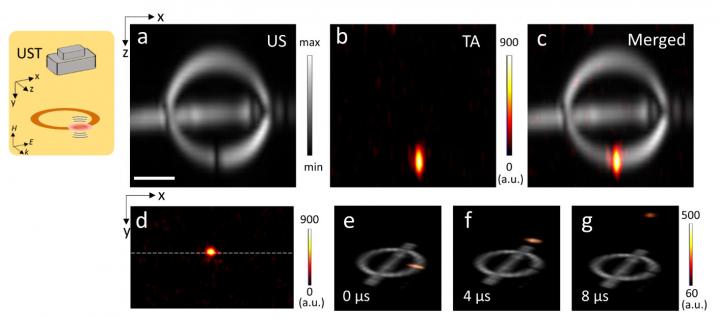Innovative wireless split-ring resonator concentrates microwaves into a hot-spot for ultrasound emission

Credit: SPIE
Ultrasound imaging is one of the workhorses in a modern hospital. It hits the trifecta of being relatively cheap, portable, and non-invasive. The ability to cause future parents to get a bit emotional over fetus images is also an appreciated perk.
But ultrasound imaging does have its limitations. Its resolution is often limited by the acoustic wavelength, which is rather long, compared to optical wavelengths. This is compounded by the limitations of acoustic transducers: they are typically optimized for a small range of acoustic frequencies, which limits the resolution of time-of-flight type measurements. Then there is the issue of getting sound waves into and out of the body. The large mismatch between the acoustic properties of the human body and air (or a solid microphone) can make for large losses. To overcome this issue, scientists and engineers have come up with some rather creative solutions, like partially immersing the patient in a bath to improve acoustic matching. Being able to place acoustic sources anywhere on the body with good acoustic matching would avoid these problems. But current technology doesn’t allow that because the transducers require a bulky power source.
Lan and colleagues, reporting in the peer-reviewed open access journal Advanced Photonics, have developed a wireless ultrasound transducer that is efficiently excited by microwaves. The result is a simple oil-filled patch that can be placed anywhere on the body. No batteries, no wires, and no bath.
Wire loop induces good vibrations
The basic principle is based on using microwave absorption to generate sound waves. Microwaves are an excellent compromise between photoacoustic imaging, which has high-resolution but low imaging depth, and traditional ultrasound imaging. Microwaves result in lower resolution compared to optical systems, but the scattering is also much lower, so excitation depth is no longer a problem. But, the body’s absorption of microwaves is also very low, so the generated sound waves are very weak.
The absorbed power is proportional to amplitude of the microwaves. A high amplitude microwave will induce a stronger acoustic wave. The unfortunate side effect is that you may inadvertently cook the person you are imaging. To avoid inadvertent cooking, the microwaves should be concentrated just where they are needed. This is what the device that Lan and colleagues have developed does.
The technique relies on the properties of the split ring resonator. A split ring resonator is a wire loop that is broken. When exposed to microwaves, a current flows in the ring. But, because the ring isn’t complete, the charge “piles up” at the gap, creating a large voltage between the ends of the wire. This large oscillating voltage means that, just in the gap, the absorbed power is high, and thermo-elastically induced acoustic waves are produced efficiently.
Now, a resonator implies that it is most efficient at a particular frequency of radiation. Split ring resonators are no exception: the resonant frequency is controlled by the diameter of the wire ring and the medium in which it is placed. Lan and colleagues chose a diameter of about 13 mm, which resonates at about 2.3 GHz in air, and 2.5 GHz in oil. But, the more important feature is the bandwidth of the resonator. Here, the researchers face a choice. To increase the amount of absorbed power, it is beneficial to have a resonator that has a very narrow bandwidth. However, to produce very short pulses of sound, the bandwidth needs to be very broad. The researchers ended up with a split ring resonator with a bandwidth of about 200 MHz, about 10-20 times that of a traditional piezoelectric transducer.
Conformal wireless resonator
The flexibility of the split ring resonator was demonstrated by a series of experiments showing that it could be used to generate mixtures of ultrasound frequencies by pulsing the microwave excitation. Acoustic frequencies up to about 2.5 MHz were produced, but, based on the resonance width of the split ring resonator, higher frequencies can likely be produced.
Probably the biggest benefit is that the resonator is just a copper ring. By placing the ring in a plastic envelope with some oil (the oil absorbs the microwaves and matches the acoustic properties of the body), the ring can be placed anywhere on the body and excited remotely. The researchers demonstrate this using a breast phantom. The ring was placed under the breast, and the detection equipment on top. The wirelessly excited ultrasound signals were strong, and the researchers show that as little as 10mW of average power is required to obtain an ultrasound signal.
Now that the proof of principle has been shown, the next step must be to build an imaging system.
###
Read the original research article in the peer-reviewed, open access journal Advanced Photonics: Lan et al., “Ultraefficient thermoacoustic conversion through a split ring resonator,” Adv. Photonics 2(3), 036006 (2020), as well as the accompanying commentary by Frederic Cegla, “Microwaves trigger thermo-acoustic ultrasound generation,” Adv. Photonics 2(3), 030501 (2020).
Media Contact
Daneet Steffens
[email protected]
Original Source
https:/
Related Journal Article
http://dx.




